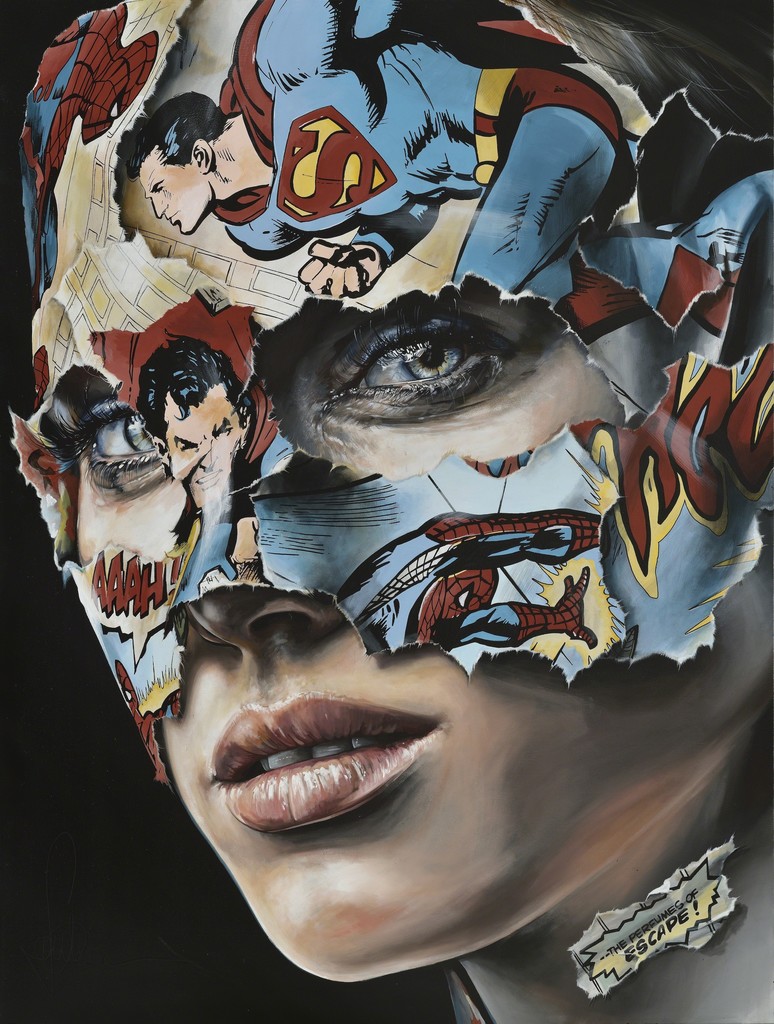‘Heroes vs Villains’ is the Mask: Sandra Chevrier’s Cage Series
Sandra Chevrier burst onto the art scene in 2013. She’s now exhibited—and importantly, sold—as far and wide as Copenhagen, Tokyo, New York, and London. In part, her burgeoning popularity rests upon our contemporary fascination with super-heroes and the renaissance in comic-culture. And yet, there’s more to her work than first meets the eye.
In La cage quand la réalité dépasse l’imaginaire (2014) there’s a young woman, who, devoid of any emotion, is staring into space. Her cheek is turned toward the viewer and upon it, as if it were another canvas, are two ‘superheroes’ shown in passionate embrace. Cage Series struck upon a simple yet highly effective formula. In brief, the subject’s face was covered-up by a mask of comic book strips. Chevrier’s paintings therefore posed interesting questions regarding identity and identification. Whose identity? And, with whom to identify? Is the subject’s identity the underlying face? Or, is it in the super-heroes battling it out on top?
Chevrier’s more recent La Cage et Les Parfums de la Fuite (2016) is in much the same style—albeit, with more of an emphasis on brushwork and technique. Consequently, each portrait is far more detailed than before. Each shows a greater commitment to realism: to the painting of each subject’s eyes; to the tiny folds of skin at their corners; to their made-up lashes, and, finally, the gloss on their lips. Their faces are also more visible—in this way, she can demonstrate her improved brushwork—and the comic book characters that do appear, now appear as properly painted découpage given one can clearly see that the comic book merely covers-up the underlying portrait rather than forming the portrait’s shape itself.
Chevrier’s superimposition of ‘superheroes’ and ‘villains’ onto portraits of women evolved from home improvement. She’d bought an Ikea dresser and, as is the unhappy fate of so much of the Ikea range, it broke. She fixed it, and, in doing so, decorated it with Marvel comic strips. Her style was born.
Intriguingly, Chevrier describes herself as a ‘collector of gazes’. She says that this is ‘just a poetic way to say I’m a portrait artist and I’m attracted to eyes that have a story to tell’. Chevrier, then, isn’t channelling the feminist film-theory of Laura Mulvey. And yet, it’s worth wondering whose gaze is being posed. It’s interesting to wonder whether the male viewer—nay, collector even—in purchasing a painting, thus purchases an ‘object’ of aesthetic pleasure and contemplation. Cage Series is ostensibly ‘about women trying to find freedom from the cages of society’s twisted preconceptions of what a woman should or shouldn’t be.’[i] Chevrier, to her credit, draws out some of these ambiguities. And yet, her models, whether imaginary or real, are, for the most part, young and attractive women.
It’s also worth considering whether the superheroes vs., villains theme re-instantiates the trope of duality and consequently, the binary forms of: good vs., evil; culture vs., nature; rationality vs., irrationality; man vs., woman; the civilised vs., the savage; or white vs., black. If so, then perhaps it’s dangerous that we, as Chevrier herself notes, ‘feel comfortable in Pop Culture Art’.
Umberto Eco’s ‘The Myth of Superman’ (1987) suggested something similar: that superheroes are too comfortable in their parochial environments. ‘Superman is practically omnipotent…From a man who could produce work and wealth in astronomic dimensions in a few seconds, one could expect the most bewildering political, economic, and technological upheavals in the world…Instead, Superman carries on his activity on the level of the small community where he lives…’ ‘He is busy by preference, not against blackmarketing drugs, nor, obviously, against corrupting administrators or politicians, but against banks and mail truck robbers.’ It’s important, then, to question what superheroes truly stand for—Eco’s suggestion is simply: private property—and ask what real superheroes would actually do…
Chevrier’s latest works are, undeniably, visually stunning. Her works will, no doubt, prove popular with consumers and collectors alike. However, it’ll be interesting to see what she does next…
[i] http://posemanikin.blogspot.co.uk/2013/05/an-interview-with-artist-sandra-chevrier.html

